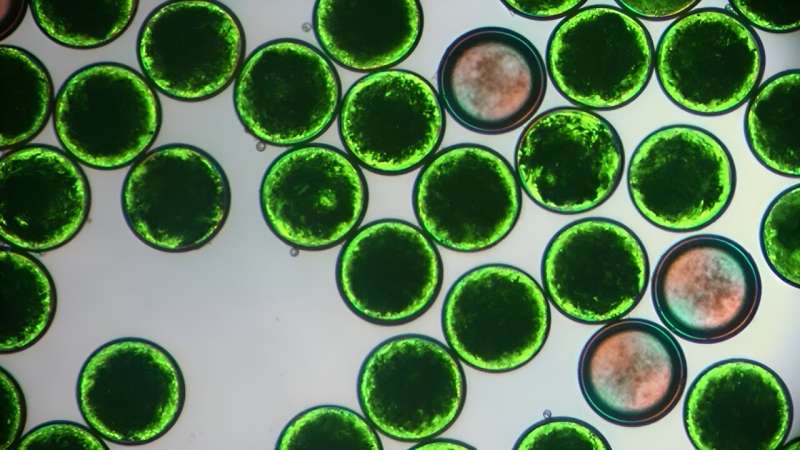This article has been reviewed according to Science X's editorial process and policies. Editors have highlighted the following attributes while ensuring the content's credibility:
fact-checked
peer-reviewed publication
trusted source
proofread
Tiny capsules that transform in the blink of an eye could be key to developing smaller electronics

Our phones and electronic devices could soon be smaller and sleeker without the risk of overheating thanks to microcapsules that transform in the blink of an eye.
Dr. Goran Vladisavljevic, of Loughborough University, and a team of researchers have designed and manufactured microcapsules filled with "phase change materials" (PCMs) that absorb heat by turning from a solid to a liquid when temperatures are elevated.
The paper, titled "Lego-Inspired Glass Capillary Microfluidic Device: A Technique for Bespoke Microencapsulation of Phase Change Materials," is published in ACS Applied Materials and Interfaces.
The capsules—which are around 0.2mm wide and do not require an energy source—could be used to absorb significant amounts of heat that would otherwise be transferred to elements in electronic devices.
They can be reused indefinitely without losing their effectiveness, says Dr. Vladisavljevic, as once temperatures drop they solidify spontaneously and "reset."
He explained, "The microcapsules rely on a natural phenomena of melting and crystallization caused when the ambient temperature is above or below the melting temperature of the phase change material.
"Suppose that overheating occurs above 80°C. Once the temperature in a device exceeds 80°C, heat energy will be absorbed by the capsules as the phase change material transitions from solid to liquid.
"When the temperature is reduced below 80°C, the stored energy will be released slowly as the phase change material starts to solidify.
"The objective is to suppress temperature peaks in electronic parts and battery packs during load peaks, for example during short periods of maximum power consumption."
Other researchers have previously been able to create PCM-containing microcapsules, but the methods used to create them involved complex, hard-to-repeat chemical processes, resulting in non-uniform microcapsules.
Dr. Vladisavljevic and team have developed a unique, highly reproducible, automatic process that produces uniform microcapsules using UV light and a special microfluidic device—the design of which was inspired by Lego bricks.
The device—manufactured at Loughborough University using an automated computer process—produces uniform droplets of PCMs enclosed within a liquid shell.
This shell hardens in several seconds when exposed to UV light, resulting in solid capsules.
Using this unique process, capsules can be made with different sizes, thicknesses, and types of PCM material, depending on what is needed, says Dr. Vladisavljevic. They can even be made magnetic, which means they could be moved around in a device to where they are needed most.
Dr. Vladisavljevic said, "There is a global appetite for smaller electronic devices, but a barrier to their development is the heat produced from electric currents flowing through the devices' integrated circuits. This research presents a solution.
"The capsules could be used for cooling electronic devices, such as smartphones or laptops, and could even be used for cooling batteries or solar energy generators.
"The capsules have been tested for mechanical stability at the University of Birmingham and for durability at Karlsruhe Institute of Technology in Germany.
"We are excited to develop the capsules further and hope to test them in industry in the near future."
More information: Sumit Parvate et al, Lego-Inspired Glass Capillary Microfluidic Device: A Technique for Bespoke Microencapsulation of Phase Change Materials, ACS Applied Materials & Interfaces (2023). DOI: 10.1021/acsami.3c00281
Journal information: ACS Applied Materials and Interfaces
Provided by Loughborough University





















